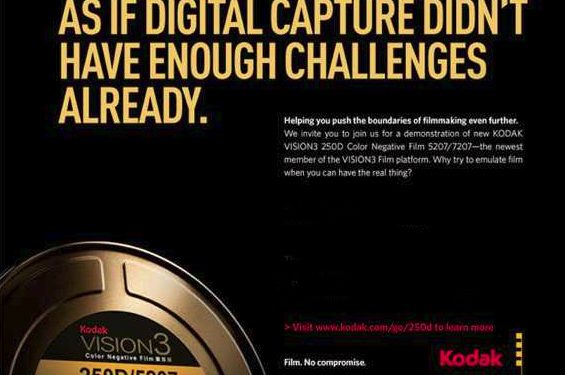[image title=”kodak” size=”thumbnail” id=”621″ align=”left” linkto=”[site_url]/wp-content/uploads/2009/05/kodak.jpg” ]I was recently invited to the Kodak Vision 3 launch of their 250D film stock. The tag line on the invitation got me thinking.. it read “If digital capture did not have enough challenges already…” – catchy line – I like it… but it made me think… what does film need to do right now.
I am not against film – I have used it almost all my career until recently, but clearly people like me also now heavily consider digital cinematography on any job. To be honest I did not mind vision 2 stock – I thought it was great, so vision 3 pushing superior low light or ultra low film grain was not pushing my buttons… so what I asked myself what would work for me ?
3 things would really get me excited I figured… see if you agree?
1. Lower cost. Producers have budget problems so making film stock or film processing less expensive at any point in the procedure would be useful, and in my opinion increasingly vital.
2. Something I cant get now… that used to be high speed or latitude – which brings me to 3
3. Why not just make the whole film process look like a data process? Why not shoot your film, send it in to the lab and get back a 16bit – high dynamic range set of data on a fast firewire 800/ E-Sata drive with all the range and latitude and no longer a 10 bit cineon file but an OpenEXR + with a matching quicktime AND DNxHD – all linking the edgecode to a DPX style timecode – ready to work. No film neg handling – no telecine, no select takes, neg pulling, no rushes, just the files ready next morning – with the quicktimes able to be dropped into FCP OR the DNxHD ready to be dropped into AVID for rushes syncing OR an option to just get the offline files and come back for the full scans that I want later (the scans being stored temporally at the lab for 1 month – saving me having to walk away with 20 firefire drives). Better still invent your own .r3d format Mr Kodak that is compressed but with the full dynamic range – go on: you guys are really bright – Cineon was a great file solution when it was first released, invent Cineon II.
These scan would be all the material we shot – but the files would have all the dynamic range of film but no longer be in 10 bit Log (which let’s face it was just a way to save about 36% of the storage over a full 16bit file back in the day when I gave a toss about disc costs). Give us OpenEXR directly if we want it. If this was ready the next morning – wouldn’t that be almost faster than even dealing with SR tapes or data transcoding ? Wouldn’t it be easier and cheaper – not to mention faster if there was a fast no questions method without expensive client in attendance (fresh muffins & latte) suites in the procedure ? Clients would never attend another transfer. (Do they even want to now?)
This seems to obvious : is this already happening ? If it is someone should run some ads promoting that and not lower film grain. I take nothing away from Kodak’s fine innovation – I just want to be able to use it !
